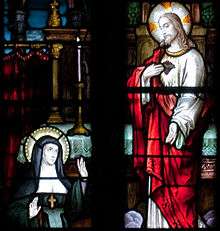Miracle of Lanciano
In Catholicism, the Miracle of Lanciano is a Eucharistic miracle which occurred in the eighth century in the city of Lanciano, Italy. According to tradition, a monk who had doubts about the real presence of Christ in the Eucharist found, when he said the words of consecration at Mass, that the bread and wine changed into flesh and blood. The Catholic Church officially claims the miracle as authentic.
The relics of this miracle currently reside in the Church of San Francesco, Lanciano in Corso Roma.[1]
History
The miracle is usually described roughly as follows: In the city of Lanciano, Italy, then known as Anxanum, some time in the 700s, a Basilian hieromonk was assigned to celebrate Mass at the monastery of St. Longinus. Celebrating in the Latin Rite and using unleavened bread, the monk had doubts about the Catholic doctrine of transubstantiation. During the Mass, when he said the Words of Consecration ("This is my body. This is my blood"), with doubt in his soul, the priest saw the bread change into living flesh and the wine change into blood which coagulated into five globules, irregular and differing in shape and size.[2] The miracle was contemporaneously investigated and confirmed by the Church, though no documents from this investigation are extant.[2]
The specimens which resulted from this miracle are currently kept in a silver ostensorium in the Church of San Francesco, Lanciano, where they are treated as relics and visited by pilgrims.
Investigations

Various investigations prove the tissue specimens are authentic, but have unusual qualities. For example, the five globules were weighed, with each globule weighing the same amount as all of them together, or as any combination of them.[2] This measurement took place during the scientific investigation and was replicated in an investigation by Archbishop Antonio Gaspar Rodríguez in 1574.
In 1971, the specimens were analyzed by Odoardo Linoli, a professor in anatomy and pathological histology as well as chemistry and clinical microscopy, and former head of the Laboratory of Pathological Anatomy at the Hospital of Arezzo.[3] The report was published in Quaderni Sclavo di Diagnostica Clinica e di Laboratori in 1971.[3][4][5] Dr. Linoli's analysis was confirmed by Ruggero Bertelli, a retired professor of human anatomy at the University of Siena.[2][6]
Linoli's conclusions
According to Linoli's study, the flesh is human cardiac tissue of type AB, consistent with the source being of Middle Eastern descent. He said he found proteins in the blood, in the same normal proportions (percentage-wise) as are found in the sero-proteic make-up of normal blood. Linoli found no trace of preservatives.[5]
Some sources claim that Linoli's study proves that the specimens are miraculous because blood would naturally decay and Linoli's analysis is based on a comparison with normal (fresh) blood, not thousand-year-old blood. However, others claim that Linoli's report in fact proves that the blood is old and not fresh blood, which would be consistent with a naturalistic explanation.[7] In either case, Linoli's study proved the specimens are authentic.
Current status
The Basilian monks kept custody of the elements until their departure in 1175. They were succeeded by Benedictine monks in 1176. The items were placed in different locations within the Church of St. Francis at Lanciano. They were kept in the Valsecca Chapel from 1636 until 1902 when they were relocated to a new altar.
When he was Cardinal of Kraków, Pope John Paul II visited the Church of St Francis in Lanciano.[8]
The elements can still be seen today. The flesh specimen, which is the same size as the large host used in the Latin Church, is fibrous and light brown in color and becomes rose-colored when lighted from the back. The blood specimen consists of five coagulated globules and has an earthy color resembling the yellow of ochre.
Pictures and documents
- Rear-lighted panel (side)
- Rear-lighted panel (front)
- Scientific recognition (18 November 1970)
- Scientific recognition (4 March 1971)
- Document by Prof. Ruggero Bertelli
- Related article in L'Osservatore Romano
- Places with similar miracles
See Also
Notes
- ↑ http://visitabruzzo.altervista.org/en/2012/12/church-of-san-francesco-lanciano/
- 1 2 3 4 Saunders, William. The Miracle of Lanciano, "Straight Answers", Arlington Catholic Herald, September 7, 2000
- 1 2 "Physician Tells of Eucharistic Miracle of Lanciano". Retrieved 2011-01-06.
- ↑ Linoli, O. "Histological, immunological and biochemical studies on the flesh and blood of the eucharistic miracle of Lanciano (8th century)"
- 1 2 "The Eucharistic Miracle of Lanciano". Archived from the original on 2006-08-31. Retrieved 2016-12-30.
- ↑ https://commons.wikimedia.org/wiki/File:Eucharistic_Miracle_of_Lanciano_-_public_documentation_-_Ruggero_Bertelli.JPG
- ↑ http://arumanchan.blogspot.co.uk/2008/08/eucharist-miracles-miracle-of-lanciano_12.html
- ↑ Pope John Paul II, "Letter To Archbishop Carlo Ghidelli Of Lanciano-Ortona (Italy)", October 4, 2004, Vatican
Links
| Wikimedia Commons has media related to Eucharistic Miracle of Lanciano. |
Coordinates: 42°13′48″N 14°23′24″E / 42.23000°N 14.39000°E
